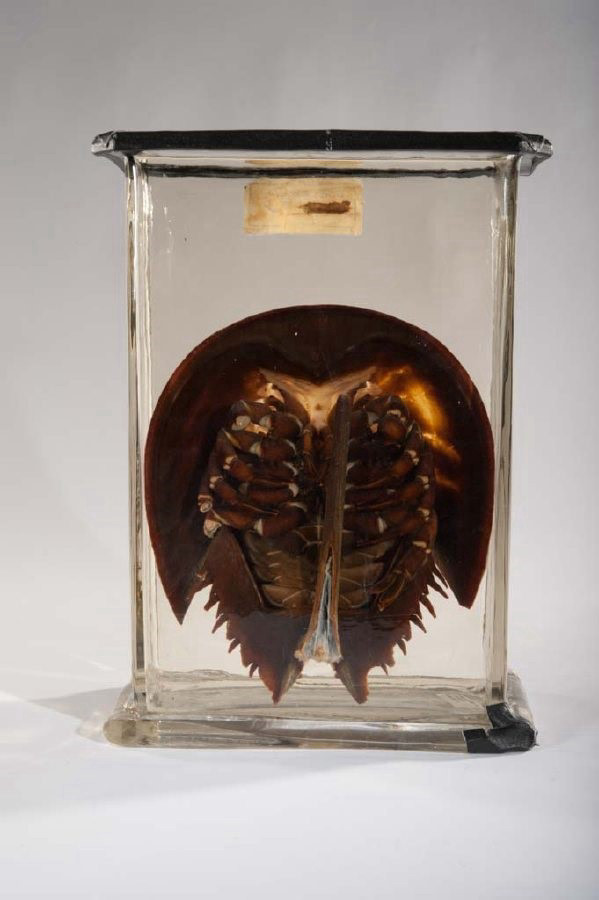
Wet specimen of a horseshoe crab with inventory number ‘ZMB 48487’ at the Museum für Naturkunde Berlin. (MfN, ZMB 48487. Image: Carola Radke/MfN. All rights reserved.)
At the Museum für Naturkunde Berlin, a specimen of a horseshoe crab  preserved in alcohol bears the inventory number ‘ZMB 48487’. It is one of a series of historical wet specimens of the species Limulus polyphemus (Linnaeus, 1758).1 Not originally part of the museum’s collection, the history of these limulus specimens is long and features many translocations. The history of these animals, and the species as a whole, provide a good example for how different scientific contexts change not only an animal’s meaning and use but its
preserved in alcohol bears the inventory number ‘ZMB 48487’. It is one of a series of historical wet specimens of the species Limulus polyphemus (Linnaeus, 1758).1 Not originally part of the museum’s collection, the history of these limulus specimens is long and features many translocations. The history of these animals, and the species as a whole, provide a good example for how different scientific contexts change not only an animal’s meaning and use but its  epistemological status and mode of existence.
epistemological status and mode of existence.
From the Aquarium via the Teaching Collection to the Museum: Provenance Histories
If the historical limulus specimens in the museum in Berlin were not originally destined for its collection, where did they come from, and what was their purpose? What routes did they take, and what can they tell us about the history of the collection?
The specimens themselves offer a clue to their earlier function. Their specific preparation indicates that they were not meant to be part of a research collection, like that of the Museum für Naturkunde Berlin. Instead it points to their use as teaching objects. The specimens were literally cut and tailored to fit  university teaching requirements. Some consisted of isolated
university teaching requirements. Some consisted of isolated  body parts that could be used to demonstrate an animal’s various functions or organs. In this case, the animal’s nervous system has been exposed.
body parts that could be used to demonstrate an animal’s various functions or organs. In this case, the animal’s nervous system has been exposed.
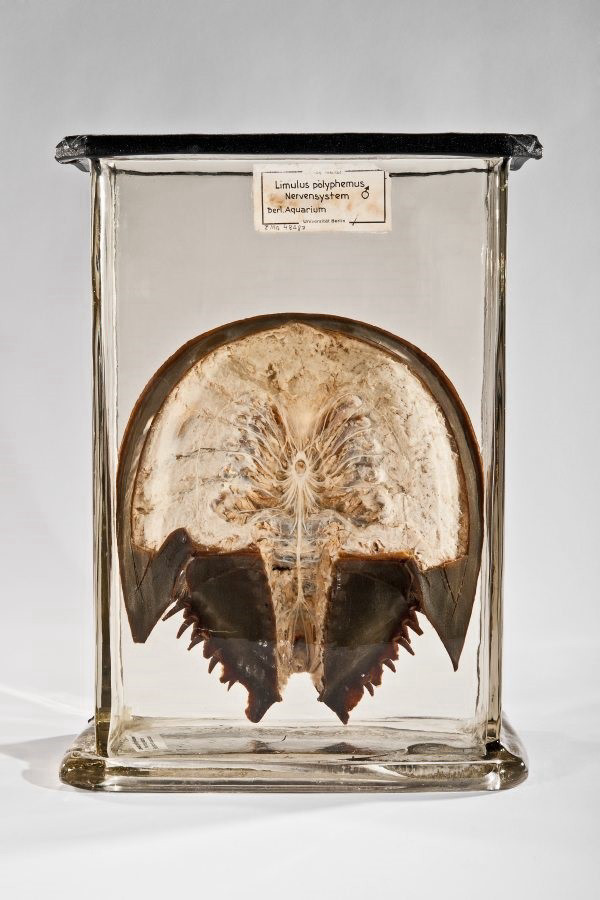
The front of specimen ‘ZMB 48487’ reveals the animal’s exposed nervous system. (MfN, ZMB 48487. Image: Carola Radke/MfN. All rights reserved.)
Organs have been removed from other animals and prepared as individual specimens.

In this specimen, the heart and vessels of a horseshoe crab have been isolated. This animal came from the (Berlin?) Aquarium and was probably part of the Zoological Teaching Collection to begin with. It is now stored at the Museum für Naturkunde Berlin. (MfN, ZMB 32114. Image: Carola Radke/MfN. All rights reserved.)
Traces of wear and tear provide more clues. Material damage and wires on some of the dry specimens indicate that they were  exhibited, hung up, and handled.
exhibited, hung up, and handled.

This historical specimen of a horseshoe crab has suffered damage over time. (MfN, ZMB 32107. Image: Carola Radke/MfN. All rights reserved.)
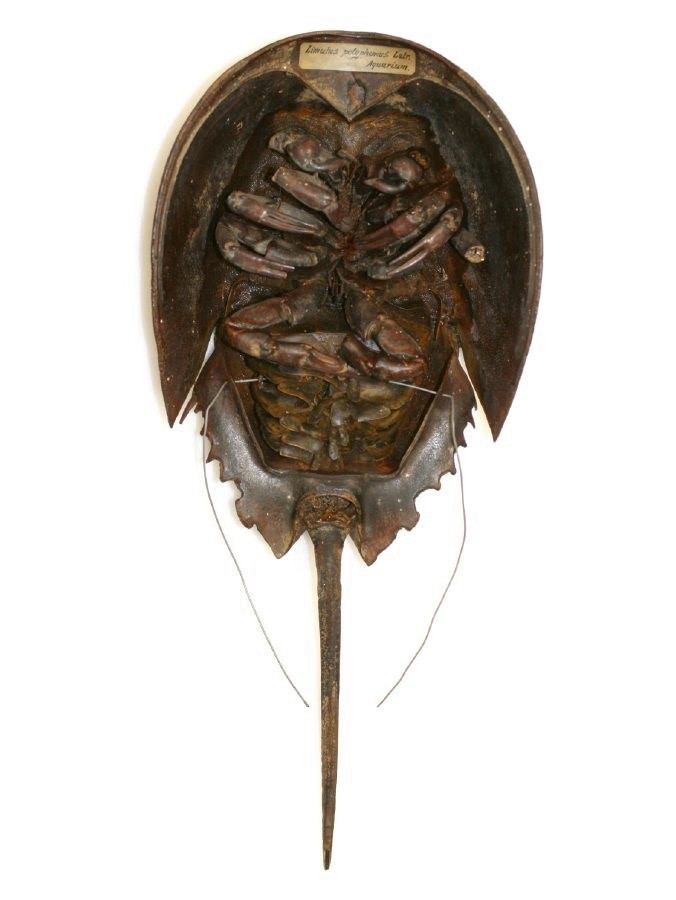
The wires on the specimen show that it was hung up, which points to its probable earlier use as an exhibition or teaching object. (MfN, ZMB 48477. Image: Carola Radke/MfN. All rights reserved.)
In fact, these specimens, as can be read at the top of the jar label, have come from the Zoological Institute. This used to be an institute at the Friedrich-Wilhelms-Universität zu Berlin that had established a  zoological teaching collection after its founding in 1884.
zoological teaching collection after its founding in 1884.
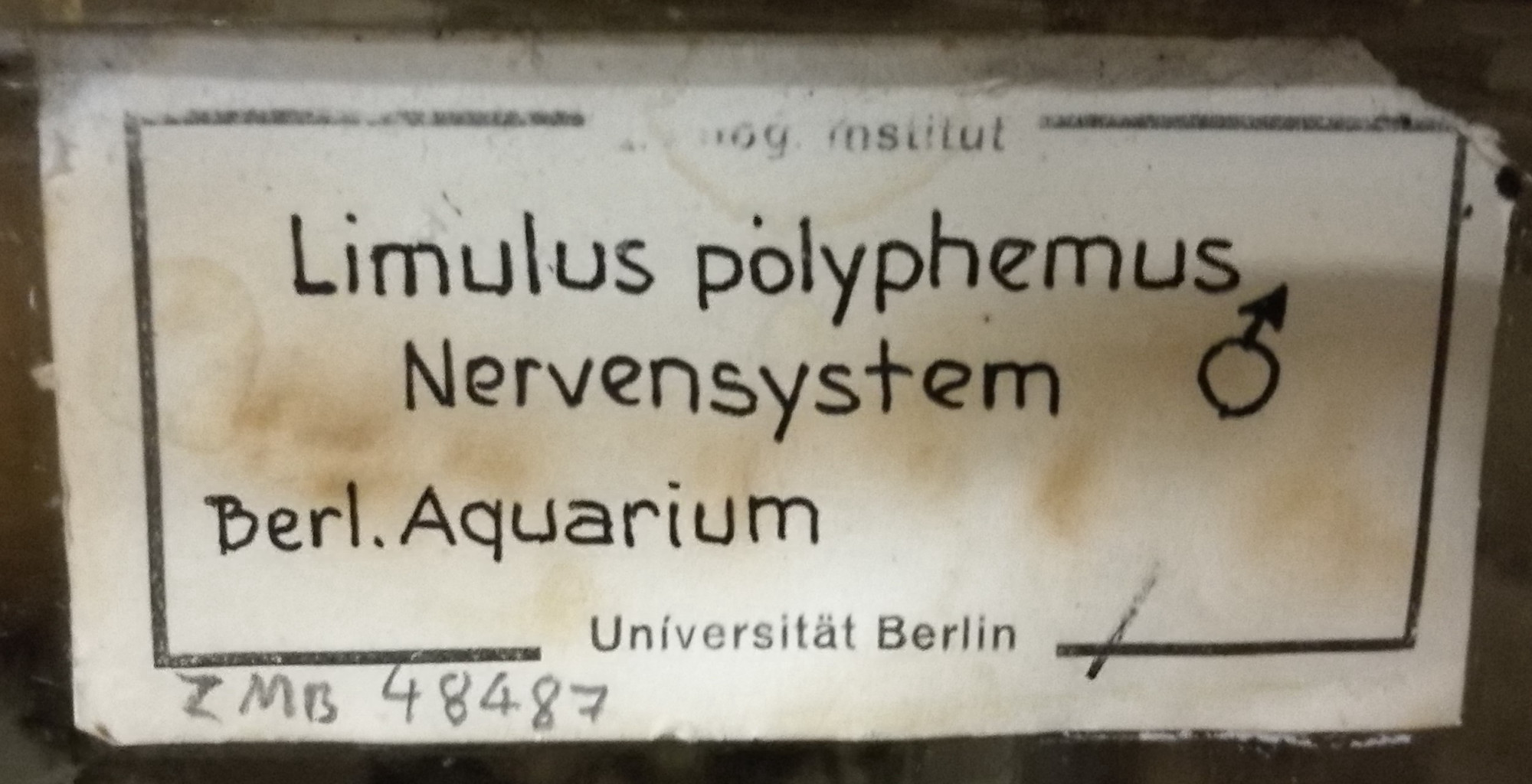
Label on the specimen from the Zoological Institute, which now bears inventory number ‘ZMB 48487’, at the Museum für Naturkunde. (MfN, ZMB 48487. Image: Mareike Vennen/MfN. All rights reserved.)
The Zoological Institute should not be confused with the collection of the Zoological Museum, which provided the initial basis for the specimens current home, the Museum für Naturkunde Berlin. Both institutions were part of Friedrich-Wilhelms-Universität zu Berlin, where they were first housed in the main building until they moved to the newly built Natural History Museum on Invalidenstraße in 1888 and 1889, respectively. However, even though they shared a roof, they largely worked independently of each other. Their functions and tasks, and, therefore, their collection structure and holdings differed markedly. While the Zoological Museum had a research collection that served scientific purposes, the Zoological Institute was responsible for training students and arranged its  teaching collection accordingly. The fact that the specimen had initially belonged to the Zoological Institute is verified by the institution’s
teaching collection accordingly. The fact that the specimen had initially belonged to the Zoological Institute is verified by the institution’s  label, on which the museum’s inventory number was noted much later. How did the specimen make its way into the Zoological Teaching Collection and from there into the museum’s research collection?
label, on which the museum’s inventory number was noted much later. How did the specimen make its way into the Zoological Teaching Collection and from there into the museum’s research collection?
In the teaching collection, the  first catalogues from the 19th century provide evidence for how limulus specimens were acquired. At that time, science had been familiar with horseshoe crabs for quite some time; there are pictures and descriptions of them that date back as far as the 16th century. However, the animals that had been available for teaching and research had mainly been dead specimens in a preserved state. According to its inventory catalogues, the Zoological Institute
first catalogues from the 19th century provide evidence for how limulus specimens were acquired. At that time, science had been familiar with horseshoe crabs for quite some time; there are pictures and descriptions of them that date back as far as the 16th century. However, the animals that had been available for teaching and research had mainly been dead specimens in a preserved state. According to its inventory catalogues, the Zoological Institute  purchased limulus specimens from the Berlin-based natural history dealer Linnaea and the Hamburg company J.F.G. Umlauff.2
purchased limulus specimens from the Berlin-based natural history dealer Linnaea and the Hamburg company J.F.G. Umlauff.2
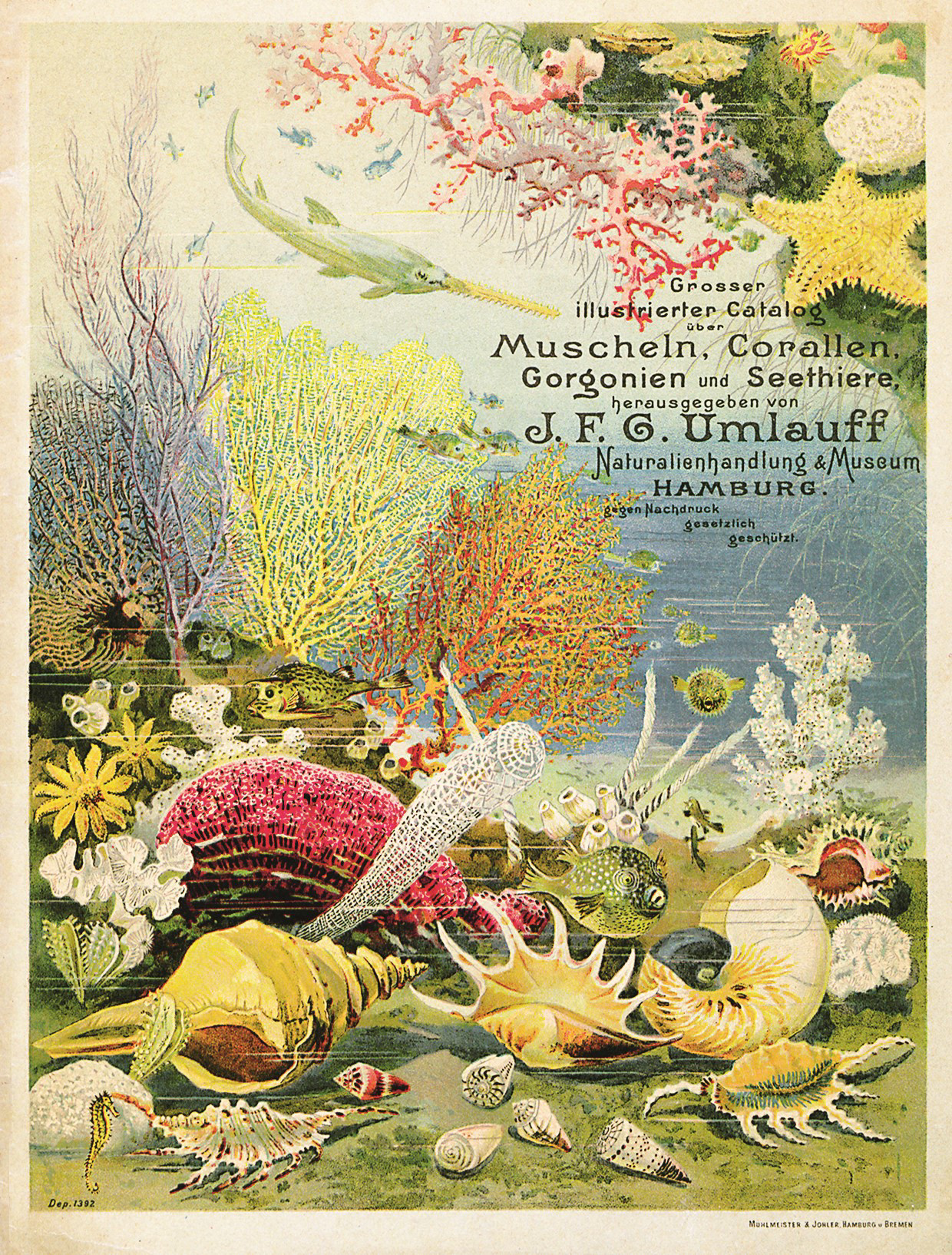
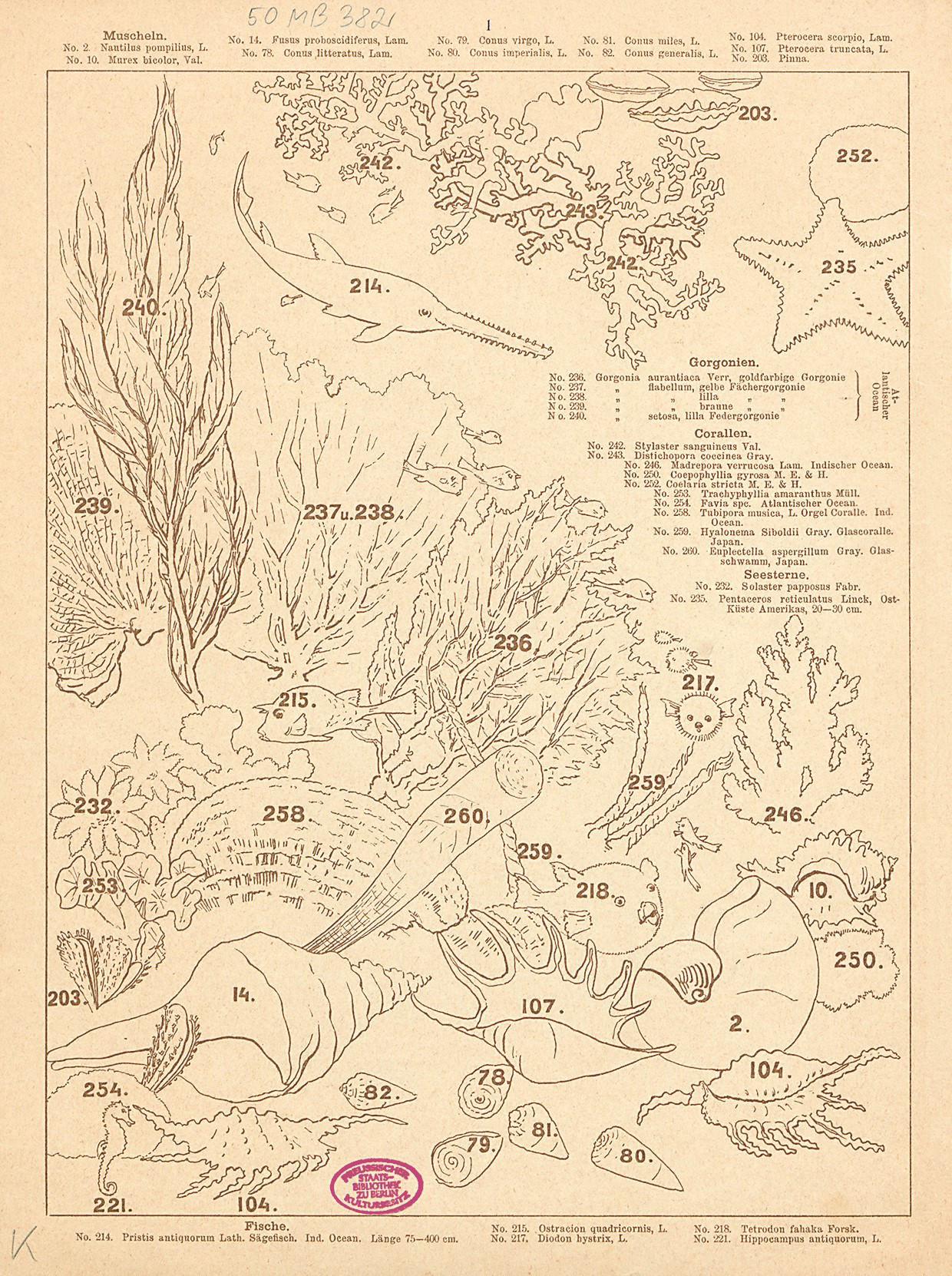
In its 1900 sea life sales catalogue, the Hamburg natural history dealer J.F.G. Umlauff had animals like horseshoe crabs on offer. Umlauff, J.F.G. (ed.). Grosser illustrierter Catalog über Muscheln, Corallen, Gorgonien und Seethiere. Hamburg: Naturalienhandlung & Museum Hamburg, 1900: left, cover; right p. 19.
In the 19th century, the practice of keeping animals in aquariums spread from the English coast throughout Europe and, shortly afterwards, reached the US. This led to the founding of a number of public aquariums in the 1860s which became further sources for zoological teaching and research collections. More and more live sea creatures that were not endemic to European waters were being imported,3 including  horseshoe crabs. Of the four extant species, three live in the Indo-Pacific waters of South East Asia, while the species Limulus polyphemus (Linnaeus, 1758) can be found in the West Atlantic and along the east coast of North and Central America.4 Most limuli in European aquariums come from the East Coast of the US, in particular from Delaware Bay in New Jersey.5 In Germany, the aquariums in Hamburg and Hanover were already showing horseshoe crabs from that region as early as the mid-1860s,6 as were the Unter den Linden Aquarium in Berlin and, from 1913, the aquarium at
horseshoe crabs. Of the four extant species, three live in the Indo-Pacific waters of South East Asia, while the species Limulus polyphemus (Linnaeus, 1758) can be found in the West Atlantic and along the east coast of North and Central America.4 Most limuli in European aquariums come from the East Coast of the US, in particular from Delaware Bay in New Jersey.5 In Germany, the aquariums in Hamburg and Hanover were already showing horseshoe crabs from that region as early as the mid-1860s,6 as were the Unter den Linden Aquarium in Berlin and, from 1913, the aquarium at  Berlin Zoo.7
Berlin Zoo.7
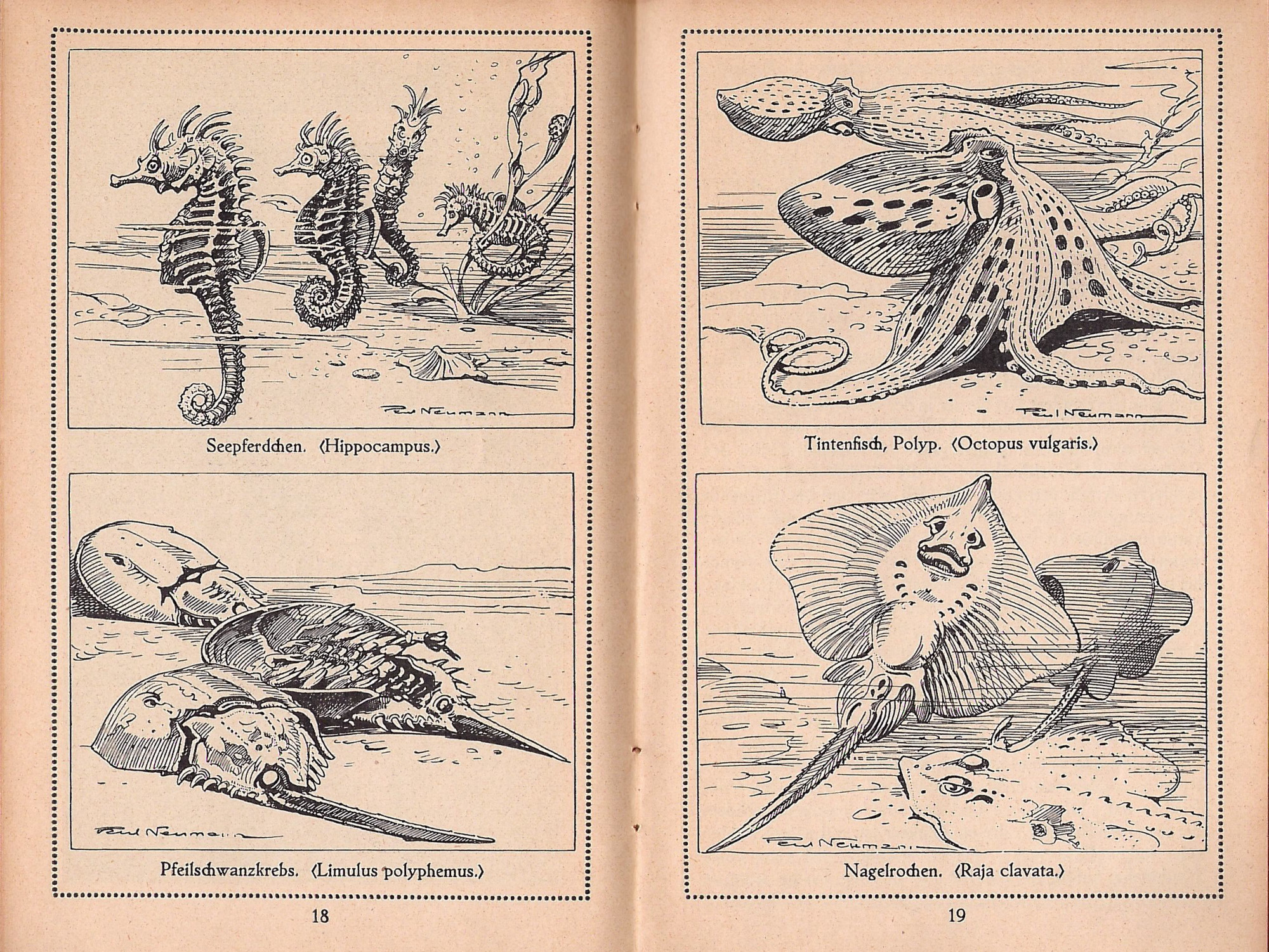
The Berlin Zoo’s aquarium guide depicted drawings of some of the sea-creatures that were on display in 1914. (AZGB. All rights reserved.)
Horseshoe crabs were also popular with private aquarists, who helped produce knowledge about their living conditions and adequate animal husbandry.

Aquarists, who were organised into associations, helped to produce knowledge about horseshoe crabs in specialist journals like the Blätter für Aquarien- und Terrarienkunde (1916).
Public aquariums donated many animals to collections after they died, thereby making them available for scientific research and teaching, including the Zoological Museum and the Zoological Institute in Berlin. The wet specimen’s label bears the inscription ‘Berlin Aquarium’.8 It had probably made its way from the New York coast to the Berlin Aquarium where it died before being dispatched to the Zoological Teaching Collection where it eventually became specimen ‘ZMB 48487’. It is not clear why, when and how it ended up in the museum’s research collection. Its transfer to the museum might have had something to do with changes to the zoological curriculum at the time. Whether this took place before the Second World War or afterwards is uncertain. But the limulus specimens might have moved to the museum (then still part of the Humboldt-Universität as well) in 1970, when the then head of collection decided to downsize it.9 So far, it has not been possible to definitively determine exactly why the teaching collection gave the animals to the museum and why the museum accepted them. At any rate, the specimens’ function gradually changed after they switched collections. While they were probably actively used in academic teaching to demonstrate the anatomy of the horseshoe crab, they are now preserved as historical specimens in the museum collection.10 Some of their eventful history – transforming from aquarium animals into teaching specimens and, ultimately, into historical  collection items – can still be seen today. The various place names that feature on the labels are now helping us reconstruct the
collection items – can still be seen today. The various place names that feature on the labels are now helping us reconstruct the  provenance of specimen ‘ZMB 48487’. The final addition so far has been the ZMB number, which is issued by the collection curator when creating the catalogue entry.11 Ocean, aquarium, teaching collection, and research collection – all of these spaces play an important role in producing and conveying knowledge about horseshoe crabs. Because these spaces compel different practices of knowing, they also produce different objects of knowledge and, thus, continuously unsettle the scientific, economic, and cultural status of the horseshoe crab.12
provenance of specimen ‘ZMB 48487’. The final addition so far has been the ZMB number, which is issued by the collection curator when creating the catalogue entry.11 Ocean, aquarium, teaching collection, and research collection – all of these spaces play an important role in producing and conveying knowledge about horseshoe crabs. Because these spaces compel different practices of knowing, they also produce different objects of knowledge and, thus, continuously unsettle the scientific, economic, and cultural status of the horseshoe crab.12
From Crab to Spider: Taxonomic Histories
Those looking for horseshoe crab specimens at the Museum für Naturkunde Berlin, however, might find themselves in the wrong collection. The problem stems from their name, which proves to be a red herring. This has to do with the history of the species or, more precisely, with the history of its scientific investigation. It is not just individual specimens like ‘ZMB 48487’ that have switched places and functions over time: the species Limulus polyphemus as a whole migrated through the taxonomic order in the 19th century and, as a result, moved around the collection structure. Science thus changed how we perceive and know the horseshoe crab, in short, it turned one animal into another.
Up until the 19th century, zoological studies assumed that limuli were crustaceans, primarily because they lived in the sea, had gills, and looked like crabs.13 As a result, the animals were classified as crustaceans. In aquariums, they were exhibited together with crabs and prawns, as they were, for example, in the world’s first public aquarium building, London’s Zoological Garden in Regent’s Park.14 A similar classification can be seen in natural history and animal trade. Umlauff, for example, placed the horseshoe crabs on offer next to crabs in its “Catalogue of Shells, Corals, Soft Corals, and Sea Creatures”.
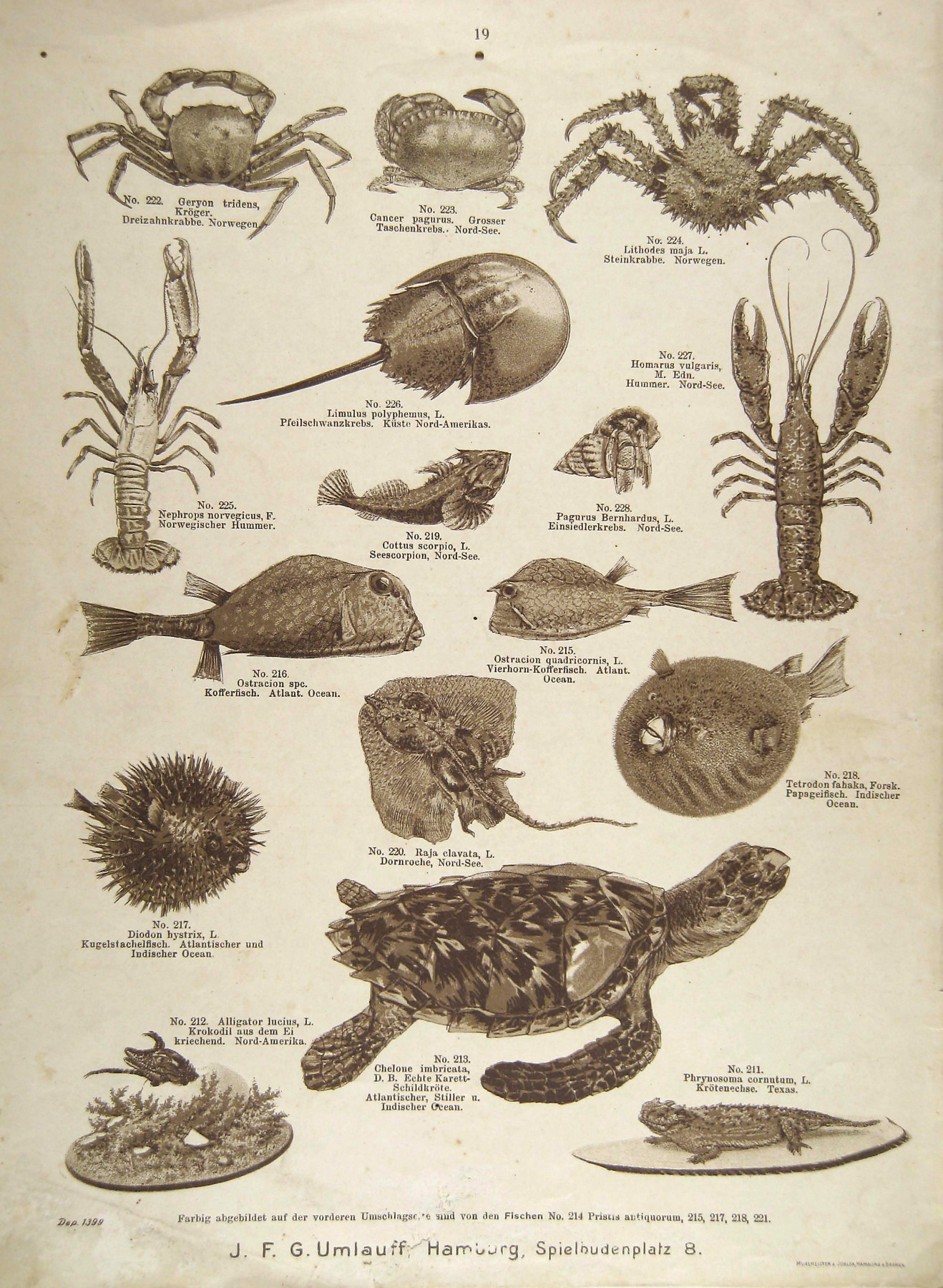
Horseshoe crabs in the sales catalogue of the Hamburg natural-history dealer J.F.G. Umlauff, Umlauff, J.F.G. (ed.): Grosser illustrierter Catalog über Muscheln, Corallen, Gorgonien und Seethiere, Hamburg: Naturalienhandlung & Museum Hamburg, 1900.
The second half of the 19th century, however, saw an increase in claims relating horseshoe crabs to arachnids rather than to crabs. A number of comparative studies were required to settle this issue of species classification. London zoologist Edwin Ray Lankester, for instance, published two pertinent articles with the title “Limulus as Arachnid” in the 1881 Quarterly Journal of Microscopical Science.15 Aquariums played another important role in these comparative anatomical studies as sites of observation and as sources for providing specimens from the 1860s onwards. Edwin Lankester, for instance, received live horseshoe crabs from the Royal Westminster Aquarium in London for his anatomical and histological studies. In Hamburg, zoologists like Karl August Möbius were given horseshoe crabs by the zoo aquarium there.16 Not coincidentally, the number of studies published on the horseshoe crab proliferated in the 1870s.17 After Lankester and others had drawn the conclusion that the animals had more in common with spiders and scorpions than with crustaceans, Limulus polyphemus was classified as a chelicerate in 1901. Thus, the horseshoe crab changed its subphylum within the taxonomic order.18
Here, the dynamics of taxonomic knowledge become visible, revealing that the  taxonomic order is subject to historical change. Within the museum, horseshoe crab specimens then migrated from the Crustacean Collection to the Arachnid and Myriapod Collection, joining the spiders and centipedes, and received a new signature.19 Their original taxonomic classification and former location within the Crustacean Collection is still visible for some of the objects at the Museum für Naturkunde Berlin. Behind the acronym ‘ZMB’ (for Zoological Museum Berlin, which allows an object to be assigned to a special collection) and the inventory number for arachnids (for example ‘48490’), there is additional information provided in brackets, which points to this species’ eventful taxonomic history:
taxonomic order is subject to historical change. Within the museum, horseshoe crab specimens then migrated from the Crustacean Collection to the Arachnid and Myriapod Collection, joining the spiders and centipedes, and received a new signature.19 Their original taxonomic classification and former location within the Crustacean Collection is still visible for some of the objects at the Museum für Naturkunde Berlin. Behind the acronym ‘ZMB’ (for Zoological Museum Berlin, which allows an object to be assigned to a special collection) and the inventory number for arachnids (for example ‘48490’), there is additional information provided in brackets, which points to this species’ eventful taxonomic history:
ZMB 48490 [ex crustacean no. 5928], 4 juveniles, alcohol; Nahant, Massachusetts, USA; leg. Fröbel, date not recorded; good condition.20
The same applies to museum exhibitions where knowledge was spatially organised according to a systematic taxonomic concept. While horseshoe crabs were displayed in the crustacean department in the 19th century, they joined the arachnids in the 20th century. On the Berlin museum’s Biodiversity Wall – a four-metre high and twelve-metre long installation that displays around 3,000 animals from all kinds of habitats – you will now find horseshoe crabs alongside scorpions and spiders.
Science has not just redefined the horseshoe crab within the taxonomic order: the way it has moved through spaces of knowledge and collection has changed the animal. In this sense, museum collections and their  research practices are also sites of world-making that reorganise nature.
research practices are also sites of world-making that reorganise nature.
From the Ocean to the Laboratory: Biomedical Histories
In the second half of the 20th century, horseshoe crabs made their way into a new scientific context. This entangled them within an experimental practice that furthered their connection to humans even more. In the mid-1950s, researchers discovered that their blood (which is blue due to the amount of copper it contains) is rich in amoebocytes, i.e., cells that immediately react to poisons.21 Consequently, medical practitioners like Frederik Bang and Jack Levin developed the Limulus amoebocyte lysate test (LAL test) from the blood of Limulus polyphemus. This test makes use of the fact that limulus blood coagulates when it comes into contact with certain bacteria. In other word, when the immune cells in the blood of the horseshoe crab encounter invading bacteria, they agglutinate around it and protect the rest of the animal’s body from the toxins. The coagulation factor, which can verify the presence of even tiny amounts of a given pathogen, can reveal the presence of bacterial contamination, also known as endotoxins.22 Since the 1970s, the LAL test has been used to determine the presence of endotoxins in human blood serum and is now sold in the United States. For this reason, when thousands of crabs come out of the sea in spring to breed and spawn (especially in Delaware Bay), they are caught by trawlers or collected on the beach and brought to specialist laboratories of biomedical companies. There, a canula is inserted into their hearts to remove up to a third of their blood. Afterwards, they are returned to where they were caught and released back into the sea alive. The short- and long-term damage caused by the bleeding is still unclear, but the number of studies dedicated to finding out is increasing.23
Biomedical research has taken horseshoe crabs to new spaces, namely, modern laboratories. In these labs, the animals – or, more precisely, their blood – are turned into a valuable resource. A few years ago, the price for a litre of limulus blood on the global market had already been estimated at about USD 15,000.24 Since the LAL test was approved, the demand for horseshoe crabs in the pharma industry has been gradually increasing. This is because the test is now the standard for screening implantable medical devices and injectable medications. It is also commonly used for testing biological samples for bacterial contamination.25 Horseshoe crabs are thus part of a long history of prospecting for and industrially appropriating living beings considered significant or lucrative
along with many other species  Cycladophoras davisiana or
Cycladophoras davisiana or  silkworms. Strictly speaking, biomedicine is not the only field in which horseshoe crabs have been exploited by humans: the animals were also used in agriculture (as fertiliser) and fishing (as bait).26 However, recent decades have seen noticeable changes in horseshoe crab populations. The unregulated capture of limuli in the late 1990s led to a drastic drop in US populations. Their use in the biotechnical industry has profoundly changed the human world but also the living conditions of horseshoe crabs. In this sense, scientific research and its applications have proven to be processes of world-making that have helped secure an important medical resource for humans. But they have also put the animals’ lives in peril.
silkworms. Strictly speaking, biomedicine is not the only field in which horseshoe crabs have been exploited by humans: the animals were also used in agriculture (as fertiliser) and fishing (as bait).26 However, recent decades have seen noticeable changes in horseshoe crab populations. The unregulated capture of limuli in the late 1990s led to a drastic drop in US populations. Their use in the biotechnical industry has profoundly changed the human world but also the living conditions of horseshoe crabs. In this sense, scientific research and its applications have proven to be processes of world-making that have helped secure an important medical resource for humans. But they have also put the animals’ lives in peril.
Moreover, their capture leads to reduced spawning activity. This is not just having an impact on the species itself but also on larger ecological contexts because horseshoe crabs are an important link in coastal biodiversity. The eggs laid by the animals each spring on the beaches of Delaware Bay are an important  food source for migratory birds like the red knot (Calidris canutus). On its annual 18,000-mile journey from Tierra del Fuego on the southern tip of South America to the Canadian Arctic and back, the red knot arrives in the bay while the horseshoe crab is spawning. The noticeable decline in horseshoe crab populations since the 1990s has thus correlated with a visible decline in red-knot population. Although catch quotas have been introduced and various initiatives taken to protect horseshoe crabs at a regional, national and international level, the International Union for Conservation of Nature (IUCN) declared the horseshoe crab endangered in 2016.27 This might have to do not least with the fact that, although an artificial alternative to the LAL test has now been developed, it has not yet become the standard in the US.28 At the same time, the demand for tests continues to grow more than ever because it is also being used in vaccine development. Since the beginning of the Corona pandemic, more than 100 different vaccines have been tested. Successful vaccines must be carefully tested before they are introduced on the market, which further increases the need for limulus serum. Horseshoe crabs are thus playing an important, albeit little-known, role in the lives of almost everybody.
food source for migratory birds like the red knot (Calidris canutus). On its annual 18,000-mile journey from Tierra del Fuego on the southern tip of South America to the Canadian Arctic and back, the red knot arrives in the bay while the horseshoe crab is spawning. The noticeable decline in horseshoe crab populations since the 1990s has thus correlated with a visible decline in red-knot population. Although catch quotas have been introduced and various initiatives taken to protect horseshoe crabs at a regional, national and international level, the International Union for Conservation of Nature (IUCN) declared the horseshoe crab endangered in 2016.27 This might have to do not least with the fact that, although an artificial alternative to the LAL test has now been developed, it has not yet become the standard in the US.28 At the same time, the demand for tests continues to grow more than ever because it is also being used in vaccine development. Since the beginning of the Corona pandemic, more than 100 different vaccines have been tested. Successful vaccines must be carefully tested before they are introduced on the market, which further increases the need for limulus serum. Horseshoe crabs are thus playing an important, albeit little-known, role in the lives of almost everybody.
Connections such as the ones outlined here and the ensuing interdependencies and dynamics frequently only become visible once we chart the paths and movements of animals and species. To do this, it is important to trace the stories of individual animals through various spaces (of knowledge), like the journey from the ocean to the aquarium, to museum collections or laboratories. This also means examining the history of the species, in particular the various disciplines, fields of application, and ecologies in which the species have played a role. Such a perspective uncovers genealogies and illustrates how the worlds and lives of humans and animals are intertwined. This knowledge can serve both, the present and the future. Uncovering connections between the routes taken by migratory birds like the red knot and the spawning activities of the horseshoe crabs in Delaware Bay has led to the development of cross-species approaches in ecology and conservation.29 Similarly, historical collection data in natural history museums and historical reports on the anthropogenic spread of  horseshoe crabs can be used to investigate urgent questions about the loss of biodiversity. In this sense, spaces of knowledge like collections and laboratories are also spaces of world-making that change living conditions, habitats, and lives. The challenge that remains is to find visions that will enable us to coexist in the future.
horseshoe crabs can be used to investigate urgent questions about the loss of biodiversity. In this sense, spaces of knowledge like collections and laboratories are also spaces of world-making that change living conditions, habitats, and lives. The challenge that remains is to find visions that will enable us to coexist in the future.
- Cf. Jason A. Dunlop, Marlene S. Compton, Anja Friederichs. “An Annotated Catalogue of the Horseshoe Crabs (Xiphosura) Held in the Museum für Naturkunde Berlin”. Zoosystematics and Evolution 88, no. 2 (2012): 215-222, 215. https://doi.org/10.1002/zoos.201200018. I would like to thank Jason Dunlop for providing so much helpful information about the specimens and their history.↩
- In 1885, for example, the teaching collection purchased a dry specimen from Umlauff for five marks; between 1891 and 1894, the catalogue recorded the acquisition of three wet specimens from the Berlin-based natural-history dealer Linnaea for two, five, and six marks respectively. Cf. Zoologisches Institut (ZIB), Inventarbuch V, vol. 1.↩
- On the history of the aquarium in the 19th century, see Mareike Vennen. Das Aquarium: Praktiken, Techniken und Medien der Wissensproduktion (1840-1910). Göttingen: Wallstein, 2018.↩
- These include Carcinoscorpius rotundicauda (Latreille, 1802), Tachypleus gigas (O.F. Müller 1785), and Tachypleus tridentatus (Leach, 1819). The North Atlantic species is classified as its own sub-family.↩
- Animal and natural history dealers were initially responsible for importing the animals. From the late 19th century onwards, New York aquarists themselves began keeping and selling the animals. In 1896, New York Aquarium opened in Manhattan’s Battery Park before moving to Coney Island. Between 1879 and 1883, there had already been one aquarium in the city, the Great New York Aquarium on the corner of 35th Street and Broadway. This had been founded by W.C. Coup, a veteran of New York’s show business and partner of P.T. Barnum. It also displayed horseshoe crabs, which it titled “King Crab”. Cf. New York Aquarium Journal, ed. by New York Aquarium 1 (1876).↩
- Cf. Wilhelm Hess. Führer durch J.G. Egestorff’s Aquarium zu Hannover: Eine kurze Uebersicht der darin befindlichen Thiere. Hanover: Druck von Wilhelm Riemschneider, 1867: 35; William Alford Lloyd. “On the Occurrence of Limulus Polyphemus off the Coast of Holland, and on the Transmission of Aquarium Animals”. The Zoologist 9 (1874): 3845-3855, 3850.↩
- On the Aquarium Unter den Linden, see Alfred Brehm. Führer durch das Berliner Aquarium: Eine kurze Beschreibung der in ihre zur Schaugestellten Thiere. Berlin: Verlag des Berliner Aquariums, 1870: 83-84. In 1920, 1925, 1928, 1930, and 1934, the New York Aquarium sent horseshoe crabs to the Berlin Zoo Aquarium. Cf. the relevant business reports from the Berlin Zoological Garden.↩
- Because specimen ‘ZMB 48487’ is undated, “Berlin Aquarium” could mean one of two institutions: The Aquarium Unter den Linden ran from 1869 to 1910, where horseshoe crabs could be viewed as early as 1870, cf. Brehm, 1870. The old collection catalogues tell us that the Zoological Institute had already received specimens from there in November 1895. (Cf. Zoologisches Institut [ZIB]. Inventarbuch V, vol. 1, no. 3409; Zoologisches Institut [ZIB], Inventarbuch V, vol. 2, no. 4301.) Three years after the building had closed in 1910, a new aquarium was opened in the Zoological Garden. Before and after the First World War, the New York Aquarium donated ten to 20 live limuli each year and also gave dead specimens to the Zoological Institute. Cf. Actien-Verein des Zoologischen Gartens Berlin. Geschäftsbericht für das Jahr 1914. Berlin: 1915.↩
- Cf. Stefan Richter. “Die Lehrsammlung des Zoologischen Instituts der Berliner Universität: Ihre Geschichte und ihre Bedeutung”. Sitzungsberichte der Gesellschaft Naturforschender Freunde zu Berlin 37 (25 February 1999): 59-76, 64.↩
- Dunlop, 2012: 215.↩
- Numbers beginning with ‘48’ were only recently assigned to predominantly older specimens, as Jason Dunlop, curator of the Arachnid Collection, explains.↩
- At the same time, knowledge about horseshoe crabs vitally depends on the lives and/or deaths of the animals (e.g., their transportability and ability to survive in the aquarium), and on their materiality (for example, the damaged materiality of dry specimens).↩
- This assumption is reflected in many of the names that were given to the animal: in German ‘Pfeilschwanzkrebs’ (arrow-tailed crab), in English horseshoe crab, and earlier even king crab. See, e.g., Otto Frederik Müller. Entomostraca seu Insecta Testacea. Havnia: Sumtibus J.G. Mülleriani, 1785; Bosc, L. S. G. Histoire naturelle des crustacés, contenant leur description et leurs moeurs: Avec figures dessinées d’après nature. Paris: Deterville, 1802; A.-G. Desmarest Considerations générales sur la classe des crustaces. Paris: Levrault, 1825.↩
- In the aquarium guide, it says: “In the tanks in the centre of the house will be found some curious Crustaceans – such as the King-crab (Limulus)”. Philip Lutley Sclater. Guide to the Gardens of The Zoological Society of London. 20th edition. London: 1876.↩
- Edwin Ray Lankester. “Limulus an Arachnid”. Quarterly Journal of Microscopical Science, New Series 21 (1881): 504-548, 609-649; see also R. Heymons. “Die Entwicklungsgeschichte der Scolopender”. Zoologia 33 (1901): 1-244.↩
- Lankester, 1881; see also Heymons 1901; William Alford Lloyd. “On the Occurrence of Limulus Polyphemus off the Coast of Holland, and on the Transmission of Aquarium Animals”. The Zoologist 9 (1874): 3845-3855, 3850.↩
- See, e.g., Anton Dohrn. “Untersuchungen über Bau und Entwicklung der Arthropoden”. Jenaische Zeitschrift für Naturwissenschaft 5 (1870): 54-81; Carl Gegenbaur. “Anatomische Untersuchung eines Limulus”. Abhandlungen der Naturforschenden Gesellschaft Halle 4 (1858): 227-250; Alphonse Milne-Edwards. Recherches sur l’anatomie des Limules. Paris: 1873; Alpheus Spring Jun. Packard. The Development of Limulus Polyphemus. Boston: Society of Natural History, 1872.↩
- This makes them special because they are the only arachnids that live under water. For the latest studies in the discussion on the taxonomy of horseshoe crab, see Richard J. Howard, Mark N. Puttick, Gregory D. Edgecombe, and Jesus Lozano-Fernandez. “Arachnid Monophyly: Morphological, Palaeontological and Molecular Support for a Single Terrestrialization within Chelicerata”. Arthropod Structure & Development 59 (2020): no. 100997. https://doi.org/10.1016/j.asd.2020.100997.↩
- Many museum and university collections still organise their collections by the biological systematics of class, order, family, genus, and species, even though spatial limitations mean that it is often difficult to implement this systematic order properly. In the second half of the 19th century, during the museum reform movement, many collections in European natural history museums were divided into a public display exhibition and a research collection that was closed to the public. Cf. Lynn K. Nyhard. Modern Nature: The Rise of the Biological Perspective in Germany. Chicago: The University of Chicago Press, 2009; Susanne Köstering. Natur zum Anschauen: Das Naturkundemuseum des deutschen Kaiserreichs 1871-1914. Cologne: Böhlau, 2003;↩
- This is the entry in Dunlop, 2012.↩
- Howell’s studies from 1881 had already proven that human blood and haemolymphe (“blood”) in the limulus coagulate in a similar way. But it took 70 years for his studies to be further developed, when Bang described a bacterial infection in a population of horseshoe crabs that caused their blood to coagulate in 1956. Cf. Manfred Liebsch. “Die Geschichte der Validierung des LAL- Tests”. ALTEX 12, no. 2 (1995): 76-80, 78.↩
- On the history of the LAL test, see, e.g., J. Levin. “The History of the Development of the Limulus Amebocyte Lysate Test”. Progress in Clinical and Biological Research 189 (1985): 3-30.↩
- Images of this procedure can be found here, for example: https://www.nationalgeographic.com/animals/article/covid-vaccine-needs-horseshoe-crab-blood (23.11.2021). For studies on the impact of taking limulus blood, see L. Hurton, J. Berkson “Potential Causes of Mortality for Horseshoe Crabs (Limulus polyphemus) During the Biomedical Bleeding Process”. Fishery Bulletin 104 (2006): 293-298; E.A. Walls and J. Berkson. “Effects of Blood Extraction on the Mortality of the Horseshoe Crab, Limulus polyphemus”. Virginia Journal of Science 51, no. 3 (2000): 195-198. Anne Rudloe. “The Effect of Heavy Bleeding on Mortality of the Horseshoe Crab, Limulus polyphemus, in the Natural Environment”. Journal of Invertebrate Pathology 42, no. 2 (1983): 187-176, https://doi.org/10.1016/0022-2011(83)90059-9.↩
- Cf. Alok Das. “Horseshoe Crabs in Modern Day Biotechnological Applications”. In Changing Global Perspectives on Horseshoe Crab Biology. Ruth H. Carmichael et al. (eds.). Cham: Springer, 2015: 463-473, 470.↩
- Das, 2015.↩
- As early as the mid-18th century, horseshoe crabs were being used in agriculture as fertiliser and then later in fishing as bait. In some regions, they are eaten as food. Cf. Loveland, R.E., M.L. Botton, and C.N. Shuster Jr. “Life History of the American Horseshoe Crab (Limulus polyphemus L.) in Delaware Bay and its Importance as a Commercial Resource”. In Proceedings of the Horseshoe Crab Forum: Status of the Resource, J. Farrell and C. Martin (eds.). Lewes: University of Delaware Sea Grant College Program, 1996: 15-22; David R. Smith, Michael J. Millard, and Ruth Herrold Carmichael. “Comparative Status and Assessment of Limulus polyphemus, with Emphasis on the New England and Delaware Bay Populations”. In Biology and Conservation of Horseshoe Crabs, John T. Tanacredi, Mark Botton, and David R. Smith (eds.). New York: Springer, 2009: 361-386.↩
- D.R. Smith et al. “Limulus polyphemus”. The IUCN Red List of Threatened Species 2016: e.T11987A80159830. https://dx.doi.org/10.2305/IUCN.UK.2016-1.RLTS.T11987A80159830.en↩
- On the testing method, see Tom Maloney, Ryan Phelan, and Naira Simmons. “Saving the Horseshoe Crab: A Synthetic Alternative to Horseshoe Crab Blood for Endotoxin Detection”. PLoS Biology 16, no. 10 (Oct. 2018). https://doi.org/10.1371/journal.pbio.2006607.↩
- See, e.g., Conor P. McGowan et al. “Multispecies Modeling for Adaptive Management of Horseshoe Crabs and Red Knots in the Delaware Bay”. Natural Resource Modelling 24, no. 1 (2011): 117-156.↩